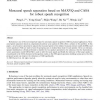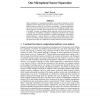ICASSP
2011
IEEE
13 years 4 months ago
2011
IEEE
Speaker recognition remains a challenging task under noisy conditions. Inspired by auditory perception, computational auditory scene analysis (CASA) typically segregates speech by...
TASLP
2008
14 years 10 days ago
2008
The predominant melodic source, frequently the singing voice, is an important component of musical signals. In this paper, we describe a method for extracting the predominant sourc...
CSL
2010
Springer
14 years 15 days ago
2010
Springer
Robustness is one of the most important topics for automatic speech recognition (ASR) in practical applications. Monaural speech separation based on computational auditory scene a...
NIPS
2000
14 years 1 months ago
2000
Source separation, or computational auditory scene analysis, attempts to extract individual acoustic objects from input which contains a mixture of sounds from different sources, ...
ICASSP
2007
IEEE
14 years 6 months ago
2007
IEEE
The goal of computational auditory scene analysis (CASA) is to create computer systems that can take as input a mixture of sounds and form packages of acoustic evidence such that ...


